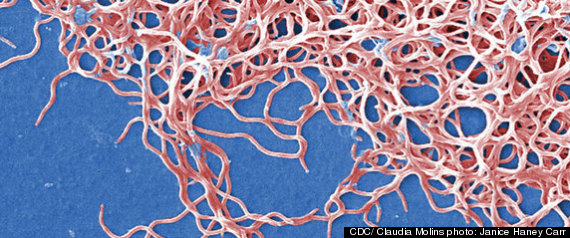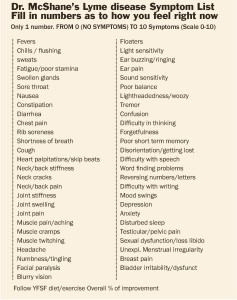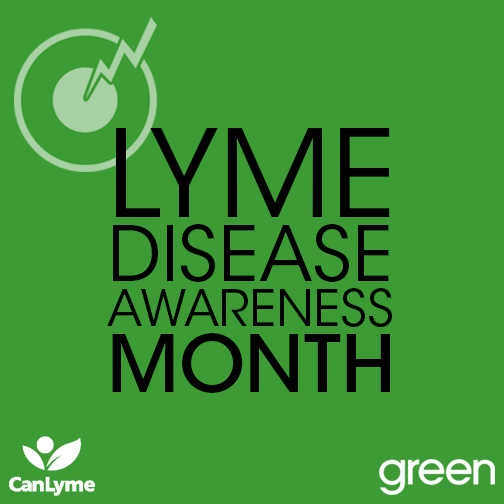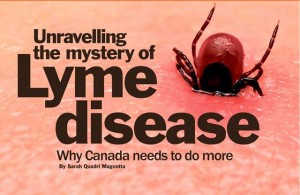What is Lyme Disease?
Lyme Disease is an inflammatory disease characterized at first by a rash, headache, fever, and chills, and later by possible arthritis and neurological and cardiac disorders, caused by bacteria (Borrelia Burgdorferi spirochetes) that are transmitted by ticks.
Did you know?
According to the Canadian Lyme Disease Foundation, only 30% of Lyme patients report experiencing a rash, and only 9% develop the classic bull's eye rash. Research has shown that the bacteria that causes Lyme Disease is present in all bodily fluids including: blood, saliva, breast milk, semen, vaginal fluids, etc. Lyme Literate MDs now believe that Lyme Disease can be passed between mother and child through the placenta and breast milk and between sexual partners. In 2013 the Centers for Disease Control and Prevention (CDC) announced that Lyme disease is much more common than previously thought, with over 300,000 new cases diagnosed each year in the United States. That makes Lyme disease almost twice as common as breast cancer and six times more common than HIV/AIDS. Early treatment of Lyme disease is critical, however Lyme is very difficult to diagnose because symptoms vary from person to person. There are over 100 known symptoms of Lyme disease. Lyme Symptoms

A cluster of Borrelia burgdorferi bacteria, which causes Lyme disease. Humans catch it when bitten by ticks. These bacteria belong to a group called spirochetes, which resemble coiled springs.
CDC/ Claudia Molins photo: Janice Haney Carr
LLMD Maureen McShane spoke to the CBC about Lyme Disease after contracting it herself.
Dr. Maureen McShane lives in Montreal and treats many Canadian patients with Lyme disease in New York State. She discusses tick bites, thebull's eye rash, the trouble with testing, Acute VS Chronic Lyme Disease, Babesiosis and many other important Lyme Disease issues. Click the link to listen to her interview.
CBC Interview with Dr. McShane
A few articles and videos to get you started.
Look under Lyme Information for more links.
Touched By Lyme: When family members don't believe you have Lyme
The Marilyn Denis Show - Lyme 101
Dr. Richard Horowitz discusses Lyme Disease
Eleven Things That Can Make A Lyme Disease Patient Feel Worse
Thought For The Day - August 9th, 2015
Does this picture resonate with you?
As soon as I saw this picture I thought, "This is my life." Or at least what it is some days and what it was most days before I started treatment; sleeping, half buried, turning to dust.
The optimist in me can see that there is still life. I can see that life is working, slowly and deliberately. And in the distance, there is a storm cloud, that while it hangs overhead looking ominous, can also bring the rain and the rejuvenation that is required to sustain a full life again.
The only way out is through. Don't give up.
Rian Michelsen is a rising star. Fifteen years ago, he was the toddler who burst out from behind the curtains singing Elvis’ Viva Las Vegas. As a young boy, he played the lead role in Oliver in his birthplace of Bermuda, before moving with his family to Toronto five years ago.
Now, as a 17 year-old high school student, he’s a gifted singer and dancer, and attends the renowned Etobicoke School of the Arts. He works as a professional actor and has appeared in numerous high profile television programs, including Murdoch Mysteries and Flashpoint. In short, Rian is more determined than ever to realize his dreams. But last year those dreams were almost destroyed by a debilitating disease that went undiagnosed for several months.
“He couldn’t get out of bed, he felt his brain shaking at night, had floaters in his eyes, he couldn’t walk and every time he stood up he felt like he was going to fall over,” explains Tanis Michelsen, Rian’s mother.
A series of blood tests revealed that Rian was reactive to the Epstein-Barr virus, had a very low white blood cell count and was low in vitamin B12. His family physician suggested Rian take vitamins and rest. He did that but still didn’t feel well enough to rehearse or perform and came home every day after school exhausted.
“We were frustrated and upset going to many specialists, having blood tests, MRIs and not getting any answers,” says Tanis. She remembers one specialist saying to Rian, “If you don’t want to go to school, you need to have a better reason.” And another specialist who, although extremely kind, professional and caring, chalked Rian’s symptoms up to a “severe case of anxiety.”
“Here is my son who has always been so grounded and active; he had never been run down like this (or anxious for that matter), so to see him not be able to participate in school and have no explanation for it was awful. Trying to find out what was happening was impossible.”
That’s when Tanis Michelsen decided she needed to look beyond the Canadian medical system.
After hearing about Lyme disease, she took the advice of a friend and contacted Dr. Maureen McShane – a family physician and Lyme disease survivor who lives in Montreal and specializes in treating patients with Lyme disease, across the border in New York. Given the prevalence of the disease in Canada and that Dr. McShane has a practice of almost 2000 patients (ninety per cent of whom are Canadians seeking diagnosis and treatment for Lyme), it wasn’t surprising Tanis had to wait a few months to get an appointment.
 In the meantime, “I was given Dr. McShane’s ‘Lyme disease symptom list’ to compare against what Rian was experiencing. Rian took one look at the list and said ‘Oh my goodness, Mom, this is it; this is exactly what I’m feeling.’ ”
In the meantime, “I was given Dr. McShane’s ‘Lyme disease symptom list’ to compare against what Rian was experiencing. Rian took one look at the list and said ‘Oh my goodness, Mom, this is it; this is exactly what I’m feeling.’ ”
In December 2014, on her own initiative, Tanis ordered and paid for testing from IGeneX – an immunology laboratory and research facility, specializing in Lyme disease and associated tick-borne illnesses in Palo Alto, California, so she could find out if Rian indeed had the disease.
Three weeks later she received the news that Rian was positive. Although she had to wait for Dr. McShane’s analysis to understand what the ‘positive’ results entailed (which protein bands were positive), the Michelsen’s were relieved they had a diagnosis, and a starting point.
As she was waiting for Rian’s results and the appointment with McShane, Tanis was desperate to get Rian the help he needed before it was too late.
“I found another physician in the U.S. – Dr. Marty Ross – who published his protocol online. He treats Lyme disease with antibiotics and herbal supplements so I convinced a friend who is a pediatrician to put Rian on doxycycline for his acne. I also followed Dr. Ross’s herbal supplement plan. It made a difference. His head cleared enough so he could hang out with his friends.”
While the protocol helped Rian, he still had grave difficulty coping with everyday life.
Tanis was also having difficulty coping. She had a husband, two young daughters – one of whom was so sick that year that she missed close to one hundred days of kindergarten – a new business plan in the works and was experiencing a flare up of her symptoms from her Fibromyalgia that she had struggled with on and off since her teenage years – something that was finally diagnosed in her early twenties, she says.
Tanis says what brought her great comfort was the many other Canadians with Lyme disease, near and far who were willing to listen to her battle and offer advice and support. They too had similar experiences and struggles with obtaining diagnoses and treatment and understanding the complexities and cost of going across the border for help.
In January 2015, Tanis received great news: Dr. McShane had a last minute cancellation and could see Rian the following day. Together, the Michelsen family drove seven hours to get Rian the medical help and support he needed.
But that’s not where this story ends. It was only the beginning for the Michelsen family who’s endured a lifelong struggle with Lyme disease that may not be over anytime soon.
A few days before travelling to Plattsburgh, Tanis connected with a mother in California whose child was diagnosed with Lyme disease. When she mentioned her Fibromyalgia was flaring up because of the stress of Rian’s illness, the mother on the other end of the phone went silent, and a few minutes later, suggested that Tanis may have been misdiagnosed so many years ago. Tanis Michelsen could have Lyme disease too.
“It was like a bomb went off in my head, explains Tanis. “All of a sudden, my mind was going crazy. I was recalling the fractures each year Rian had between ages five and fourteen. I remember saying out loud: Rian has had Lyme disease his whole life and he got it from me.”
The revelations about her children continued. Her youngest daughter, Lyla, 7, has been sick her whole life. Lyla was colicky as a baby, and when she was old enough to communicate, she suffered from daily stomach pain, nausea and chronic diarrhea. She also had constant ear infections – almost one every six to eight weeks from age two to age six. She had pneumonia more than once, and persistent dark circles under her eyes.
And while Tanis, herself, thought she was having heart palpitations from the stress of Rian being so sick, she realized that she too was sick – possibly sicker than anyone in her entire family.
“I’ve had symptoms since I was fourteen that started with headaches and a dreamy, foggy feeling. My headaches were so bad that I sought out cranial therapy which really helped me. Up until this year, I spent a lot of time treating my ‘so called’ Fibromyalgia,” Tanis explains.
According to Dr. McShane – who is caring for the entire Michelsen family (Tanis’ husband Brett and their middle child, Jade 11, also tested positive for Lyme) – studies have shown a possibility that Lyme disease can be transferred from a mother to her children in utero and between spouses through sexual intercourse. However, the U.S. Centers for Disease Control (CDC) says there is no credible scientific evidence that Lyme disease can be spread from person-to-person through sexual contact. Attempts to demonstrate sexual transmission in infected animals have all failed, and there has not been a single, adequately documented case of sexual transmission of Lyme disease reported in the scientific literature. The sources listed on their website are dated from 1989 through to the most recent in 2001.
MORE: THE ASSISTED DYING DEBATE: UNDERSTANDING THE SUPREME COURT RULING
While the Public Health authorities don’t agree that science has demonstrated sexual or in-utero transmission, doctors who specialize in Lyme disease, like Dr. McShane are seeing evidence that suggests it is possible.
While the Michelsen’s case is atypical, it’s not as uncommon as one might think and is an excellent example of the struggles Canadians are experiencing trying to get answers, testing, diagnoses and treatment for Lyme disease.
As concern about Lyme disease gains momentum and awareness spreads, experts want the Canadian health care profession to realize that Lyme disease is a serious threat to public health and Canada needs to improve its testing in order to help sufferers.
Health care professionals need to have Lyme disease on their radar, even if they are in urban areas. “It’s not all about ticks, it’s about co-infections like Babesia and Bartonella – and over twenty more strains of bacteria that exist in nature. Mosquitos are carrying Lyme as well,” warns McShane. No matter where you go in Canada, there is a possibility. And if you go to the Dominican Republic, sand fleas are carrying Bartonella.”
Grandpa’s Run 4 Lyme
On January 2, 2015, David Woodhall, 73, quietly started running on his YMCA track in Waterloo, Ontario. He has a plan to run across Canada, starting at St. John’s Newfoundland and finishing in Vancouver, British Columbia, hoping that if he got injured in running, he could continue on a bike or in the pool doing laps.
He has run over 2096 km as of June 29, 2015 and has already crossed from Newfoundland into Nova Scotia then into P.E.I., through New Brunswick and now he is into Quebec.
Why is he doing this at his age?
The run to raise awareness, education and to fund-raise is for his grandson, James D. His mother, a Lyme patient who was misdiagnosed at the time, nursed both him and his sister as infants, and he began to show signs of Lyme disease when he was only eight years old. Today he is 16. He has brain damage affecting most facets of his memory, executive functioning, concentration and ability to make connections and cannot go to school. He has multiple complication diagnoses, faints, sometimes walks with a cane and has extreme pain every moment of every day. He is sleep deprived and isolated and fights to stay upbeat and positive, but it has been and continues to be a long, hard road to recovery.
To see the full story or to make a donation to help cover David's grandson's medical bills, please check out: www.grandpasrun4lymedisease.com

What are Co-Infections?
Co-infections are just what they sound like. Many Lyme patients have other infections, either through the same tick bite or from another bite from a different insect at a different time. Many of these co-infections remain dormant until their immune system is compromised. Some of the most common Lyme Co-infections are Babesia, Bartonella, and Ehrlichia.
The following symptoms were excerpted from Diagnostic Hints And Treatment Guidelines For Lyme And Other Tick Borne Illnesses, by Joseph J. Burrascano Jr., M.D. (Fifteenth Edition 2008).
Babesia (Babesiosis)
A protozoan spread by ticks, blood transfusion, and in utero.
Air hunger
Cough
Fatigue
Fevers
Headache
Hemolysis
Imbalance without true vertigo
Mild encephalopathy
Shaking chills
Sweats
Bartonella (Bartonellosis, also known as cat scratch fever)
Spread by bites from infected ticks and in utero.
abnormal liver enzymes
encephalopathy
endocarditis
flu-like malaise
headache
hemolysis with anemia
hepatomegaly
high fever
immune deficiency
jaundice
lymphadenopathy
myalgias
myocarditis
papular or angiomatous rash
somnolence
sore throat
splenomegaly
weakened immune response
Ehrlichia (Ehrlichiosis)
Spread by bites from infected ticks
elevated liver enzymes
headaches
myalgias
ongoing fatigue
persistent leukopenia
thrombocytopenia
Co-infections must be treated along with Lyme Disease in order to make have the best chance of recovery.
The Link Between Lyme and MS
Information from: The National Multiple Sclerosis Association
Lyme disease can cause delayed neurologic symptoms similar to those seen in multiple sclerosis (MS) such as weakness, blurred vision caused by optic neuritis, dysesthesias (sensations of itching, burning, stabbing pain, or “pins and needles”), confusion and cognitive dysfunction, and fatigue. Lyme disease symptoms may also have a relapsing-remitting course. In addition, Lyme disease occasionally produces other abnormalities that are similar to those seen in MS, including positive findings on magnetic resonance imaging (MRI) scans of the brain and analysis of cerebrospinal fluid (CSF).
These similarities in symptoms and test results have led some people with MS to seek testing for the presence of antibodies to Borrelia, to determine if their neurologic symptoms are the result of Lyme disease or truly MS. The distinction is important because Lyme disease, especially when treated early, often responds to antibiotic therapy, whereas MS does not.


Avril Lavigne on Good Morning America in her first television interview since her diagnosis:
Thank you Avril for shining a light on this terrible disease.
Daniel Corso and Tanner Cookson rode across Canada to bring awareness about Lyme Disease.

These inspiring guys are from St. Catharines, Ontario. Daniel and Tanner started their ride in Maple Ridge, British Columbia in May and after 8,310 kms, ended up in St. Johns, Newfoundland. Congratulations to them for completing such an amazing journey and thank you Daniel and Tanner from the Lyme community! Please check them out on Facebook to show your support and read their daily ride dedications.

Check out the article below:
Holy Cow Canoe Corp. to raise funds, awareness for Lyme Disease.
Holy Cow Canoe Corporation general manager Gulam Baloch, left, his wife Naomi McQuade, artistic director and Shawn Best, boat builder are hosting an auction on eBay.ca with one of their custom-built canoes, donating all proceeds to CanLyme, the Canadian Lyme Disease Foundation.
(Photo by Neil McKenzie-Sutter)
Advocate Daniel Scavino talks about the impact Lyme disease has had on how wife for the last 14 years, and how he is now raising awareness about the issue by taking a bite out of Lyme! Also, Dr. Leo Galland of the Foundation for Integrated Medicine talks about prevention and diagnosis.

On November 27th, 2014, Mr. Michael Mantha, MPP for Manitoulin-Algoma, tabled a motion in the Ontario Legislative Assembly which asked that the Minister of Health develop a provincial strategy for Lyme disease. (www.ontariolymealliance.ca)
On May 6th, Michael Mantha was fighting for the Ontario Lyme community again as he challenged Eric Hoskins, the Minister of Health, for a timeline and consultation with Lyme stakeholders.
Thank you Michael Mantha!

Ashley Olsen has been diagnosed with Late Stage Lyme Disease.
It is being reported that Ashely Olsen has been battling Late Stage Lyme for a few years now.
Read the article here:

March 1st kicks off the #lymesuckschallenge.
To help raise awareness and funding for more research and support, the Canadian Lyme Disease Foundation (CanLyme) in conjunction with Lyme groups across North America, is asking for you to suck a lime and pass it on. Get a picture or a video of you sucking a lime and post it to social media with the #lymesuckschallenge. You can nominate others to do it, you can educate people about Lyme and you can encourage family and friends to make a donation to CanLyme.
To find out more, go to:
To make a donation, go to:


And the Green Party continues their fight against Lyme Disease. Elizabeth May brought the Lyme Disease Bill to parliament and now is continuing to fight for Canadian Lyme Patients.
Green Party - Lyme Disease Release

My name is Jodi Stansfield and six years ago I became ill. Over four years ago my health deteriorated and I had to take a leave of absence from my career. After seeing over thirty doctors and having countless tests, I can now confirm that I have Late Stage Lyme Disease.
Lyme disease is in Canada. Through this process I have learned that it is, in fact, all around us. Effective testing and treatment must be done through the United States at this point, but the disease itself is here. In December of 2014 the House of Commons passed Bill-C442, The National Lyme Disease Strategy Act, which will promote awareness and prevention of Lyme, address the challenges of timely diagnosis and treatment and push for further research. There is a long way to go, but Canada is slowly beginning to realize this is becoming a national crisis. The Act is endorsed by the Canadian Medical Association, the College of Family Physicians of Canada, and the Canadian Lyme Disease Foundation.
If people you know are suffering from neurological problems, debilitating fatigue, balance problems, joint pains, memory and cognitive problems, etc. please encourage them to have Lyme testing through the U.S. done so they can include or exclude it in their search for an answer. Many Canadians have been misdiagnosed with MS, Lupus and Fibromyalgia. It is worth looking into. I wish I had known that the Lyme tests I did in Canada, when I first got sick and again a few years ago, were deeply flawed and ineffective at detecting Lyme. I would like to help others who are battling for their quality of life. I would like them to get their answer sooner than I did.
Please help spread the word that Lyme disease is in Canada.
Thank you for visiting our site.
Our goal is to build a resource for others
with Lyme disease.
updated August 2015




